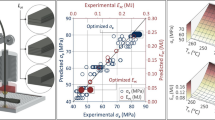Abstract
Particle size and press time are always two effective factors in the manufacturing of particleboard. In this work we have investigated the effect of these factors on thin particleboard. Experimental 3 mm panels were made while particle size, press time and type of resin have been changed in 4, 3 and 3 levels respectively. Modulus of rupture, internal bond strength, modulus of elasticity, water absorption (2 and 24 h) and thickness swelling (2 and 24 h) of the panels made with a target density of 0.65 g/cm3 were investigated. Based on the results of this work, the particleboards made from phenol formaldehyde resin with mixed size particles in 180 s press time, showed the maximum flexural strength (18/46 MPa). The highest MOE (2027/55 MPa) was found for particleboards that made from melamine formaldehyde resin with particle in size −12 + 18 mesh and 120 s press time. Internal bonding of the panels made with melamine formaldehyde resin, particle size −12 + 18 mesh and 180 s press time exhibited the best results (1/75 MPa). Besides, the best panels in term of thickness swelling were made from phenol formaldehyde with particle size −8 + 12 mesh and 180 s press time. The lowest amount of water absorption for panels manufactured from phenol formaldehyde resin with mixed particles and −18 + 20 mesh and 180 s press time happened.




Similar content being viewed by others
References
Ashori A, Nourbakhsh A (2008) Effect of press cycle time and resin content on physical and mechanical properties of particleboard panels made from the underutilized low-quality raw materials. Ind Crops Prod 28:225–230
ASTM D 1037-93 (1995) Standard methods for evaluating properties of wood-based fiber and particle panel materials. American Society for Testing and Material, Philadelphia
ASTM E828–81 (1997) Standard test method for designating the Size of RDF-3 from its sieve analysis. American Society of Testing and Materials. West Conshohocken, Philadelphia, pp 699–706
Badejo SO (1988) Effect of flake geometry on properties of cement-bonded particleboard from mixed tropical hardwoods. Wood Sci Technol 22:357–370
Cai ZY, Wu QL, Lee JN, Hiziroglu S (2004) Influence of board density, mat construction, and chip type on performance of particleboard made from eastern red cedar. For Prod J 54(12):226–232
Charoenwong C, Pisuchpen S (2010) Effect of adhesives and particle sizes on properties of composite materials from sawdust. In: Proceedings of the 7th IMT-GT UNINET and the 3rd International PSU-UNS Conferences on Bioscience
Frybort S, Mauritz R, Teischinger A, Muller U (2008) Cement bonded composites—a mechanical review. J Bioresour Technol 3:602–626
Juliana AH, Parideh MT, Rahim S, Nor Azowa I, Anwar UMK (2012) Properties of particleboard made from kenaf (Hibiscus cannabinus L.) as function of particle geometry. Mater Des 34:406–411
Li X, Cai Z, Winandyc JE, Bastad AH (2010) Selected properties of particleboard panels manufactured from rice straws of different geometries. Bioresour Technol 101:4662–4666
Maloney TM (1973) Bark boards from four west coast softwood species. Forest Prod J 23(8):30–38
Moslemi AA (1974) Particleboard. Volume1: materials. Southern Illinois University Press, Carbondale, p 244
Nemli G, Aydin I, Zekovic E (2007) Evaluation of some of the properties of particleboard as function of manufacturing parameters. Mater Des 26:1169–1176
Nishimura T, Amin J, Ansell MP (2004) Image analysis and bending properties of model OSB panels as a function of strand distribution, shape and size. Wood Sci Technol 38:297–309
Philippou JL, Zavarin E, Johns WE, Nguyen T (1982) Bonding of particleboard using hydrogen peroxide, lignosulfonates, and furfural alcohol, the effect of process parameters. Forest Prod J 32(3):27–32
Rayner CA (1969) Amine formaldehyde resins. In: Mitlin L (ed) Particleboard manufacture and applications. Press Media Books Ltd., London
Rokiah H, Norhafizah S, Othman S, Sugimoto T, Hiziroglu S, Sato M et al (2010) Effect of particle geometry on the properties of binderless particleboard manufactured made from oil palm trunk. J Mater Des 31:4251–4257
Suchsland O, Woodson GE (1990) Fiberboard manufacturing practices in the United States. USDA, Forest Serv, Washington Agr handbook no. 640. p 263
Turgut SH, Burak AM (2011) Weathering performance of particleboards manufactured from blends of forest residues with red pine (Pinus brutia) wood. Maderas. Cienc y Tecnol 13(3):337–346
Viswanathan R, Gothandapani L, Kailappan R (2000) Water absorption and swelling characteristics of coir pith particle board. Bioresour Technol 71:93–94
Wang D, Sun XS (2002) Low density particleboard from wheat straw and corn pith. Ind Crops Prod 15:43–50
Yang HS, Kim DJ, Kim HJ (2003) Rice straw-wood particle composite for round absorbing wooden construction materials. Bioresour Technol 86(2):117–121
Zhang H, Zhiren G, Hunt JF, Feng F (2010) Measuring modulus of elasticity for thin wood composites by using the dynamics method. J Beijing For Univ 32920:149–152
Zhang H, Hunt JF, Huang Y (2013) Detection and analysis of the stress relaxation properties of thin wood composites using cantilever beam bending. 18th International Nondestructive Testing and Evaluation of Wood Symposium, Madison
Author information
Authors and Affiliations
Corresponding author
Rights and permissions
About this article
Cite this article
Farrokhpayam, S.R., Valadbeygi, T. & Sanei, E. Thin particleboard quality: effect of particle size on the properties of the panel. J Indian Acad Wood Sci 13, 38–43 (2016). https://doi.org/10.1007/s13196-016-0163-9
Received:
Accepted:
Published:
Issue Date:
DOI: https://doi.org/10.1007/s13196-016-0163-9




